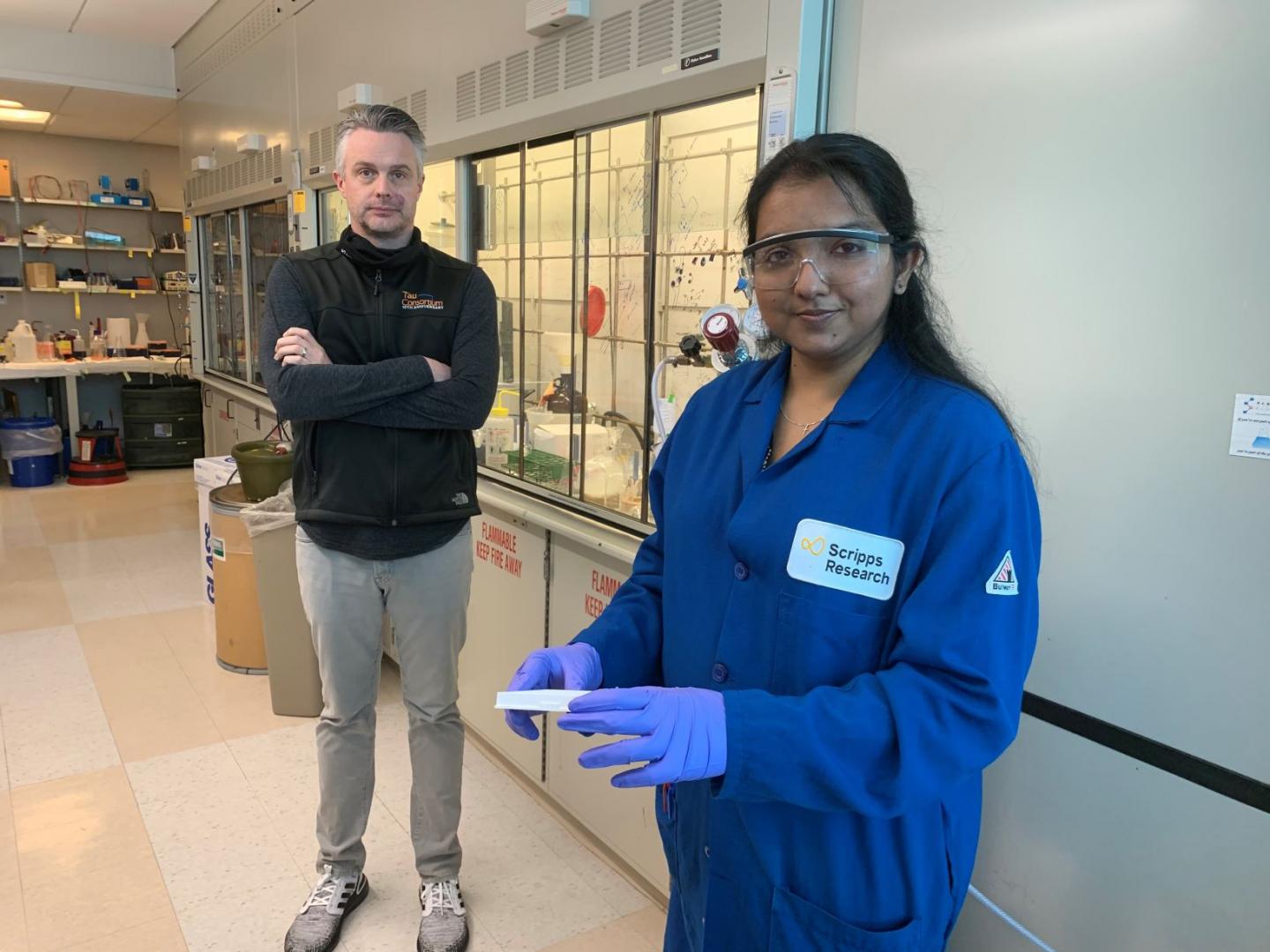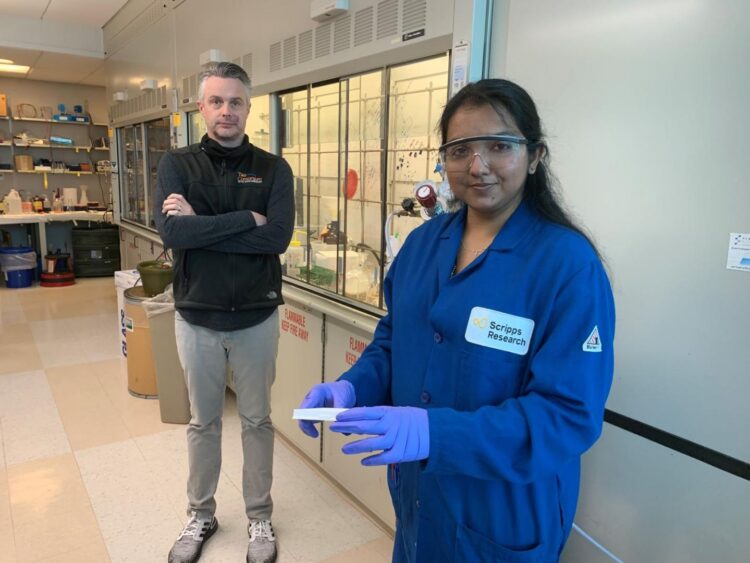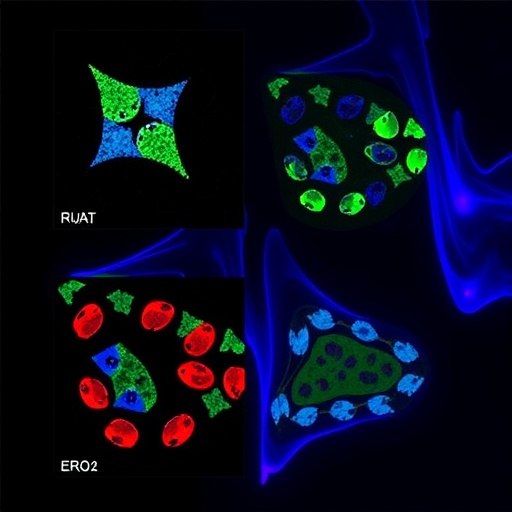‘Functionalized fragments’ help design RNA medicines against a cancer target

Credit: Scripps Research
JUPITER, Fla. –Dec. 14, 2020–Imagine trying to throw a bullseye when the dartboard lies buried within a crumpled box. That’s the challenge faced by scientists working to make new medicines for some “undruggable” diseases, including a type of metastatic breast cancer.
Scientists refer to diseases as “undruggable” when their targets lie on a protein molecule that folds inward, or in a way that shields the active site from would-be treatments.
Addressing this problem of “undruggable” proteins, a team of Scripps Research scientists has invented a tool that bypasses the awkward proteins completely, and instead modifies elements involved in their construction and regulation. This new tool, called Chem-CLIP-Fragment Mapping, focuses on RNA, molecules that read genes and help build proteins, among other duties.
RNAs have not been viewed as drug targets until recently, due to challenges that include a short-lived existence, changeable shape, and limited array of building blocks. The new RNA drug-discovery tool, described in Monday’s issue of the Proceedings of the National Academy of Sciences, addresses these and other challenges to enable both the rapid discovery and optimization of RNA-targeting compounds, says Chemist Matthew Disney, PhD, of Scripps Research, Florida.
“It allows us to tackle very hard molecular recognition problems to enable us to make lead medicines across multiple indications,” Disney says. “This opens great potential to redefine what’s truly ‘undruggable.'”
Disney and first author Blessy Suresh, a graduate student in his lab, demonstrate the tool’s power by identifying a medicinal compound that acts on an important breast cancer target. Their article, “A general fragment-based approach to identify and optimize bioactive ligands targeting RNA,” was written in collaboration with Scripps Research Chemist Christopher Parker, PhD.
The system adapts a recent advance in protein-targeting drug-discovery which uses weakly binding, drug-like chemical fragments to reveal promising templates. Here, the fragments are “functionalized,” or appended with tags and light-sensitive modules, allowing them to be seen and identified, a protein-targeting strategy originally developed by Parker as a postdoctoral fellow in the lab of Scripps Research biochemist Benjamin Cravatt, PhD. Key to the system’s use with RNA are technologies and databases built in Disney lab over a decade.
“This is what Scripps Research is, we develop tools,” says Parker, now an assistant professor at Scripps Research, Florida. “Our collaborative environment allows us to do this.”
The Chem-CLIP-Frag-Map system accelerates the drug-discovery effort because it reveals multiple opportunities to bind, and hence modify, the RNA targets, Disney explains. This helps scientists engineer and optimize potential medicines to bind more tightly, be more specific, and less apt to have off-target side-effects, right from the beginning, saving time.
“These two things bind cooperatively, and so the whole is better than the parts,” Disney says.
For their proof-of-concept study, the Scripps Research team used the Chem-CLIP-Frag-Map tool to find compounds for microRNA-21, a key RNA involved in triple-negative breast cancer, an aggressive type of breast cancer that lacks precision-targeted treatments.
“The system helped us optimize the fragments to design bioactive complexes with higher selectivity and potency as compared to starting fragments,” Suresh says. “We were able to screen 460 fragment-based probes in just a couple of hours. This screening method can be easily scaled up to a much more high-throughput format.”
The Chem-CLIP-Frag-Map tool uses a light-sensitive module called a diazirine group that covalently crosslinks to RNA with exposure to UV light.
“This is a chemical that has a weak magnet-like attraction to other nearby molecules. So when it’s placed near disease-associated proteins, or now RNAs, it can thus bind to them, revealing the shape a medicine would need to take to bind to that disease-associated protein or RNA,” Disney explains.
Most people diagnosed with breast cancer respond to a precision medicine, such as those that act on the hormones estrogen or progesterone, or those that target a protein called HER2. People whose cancer doesn’t fit either of those categories are dubbed “triple negative.” Triple-negative breast cancer affects 10 to 15 percent of all people diagnosed with breast cancer. Triple-negative breast cancers tend to be more aggressive, and have a worse prognosis, as some key proteins have been deemed undruggable.
The new drug-discovery tool shows that undruggability need not end the search for precision treatments, Disney says.
“For every protein encoded in human DNA, there are 75 or 80 types of RNA encoded, so this new tool offers great hope for virtually all diseases now deemed ‘undruggable,’ including triple-negative breast cancer,” Disney says.
###
Media Contact
Stacey DeLoye
[email protected]
Original Source
https:/
Related Journal Article
http://dx.





